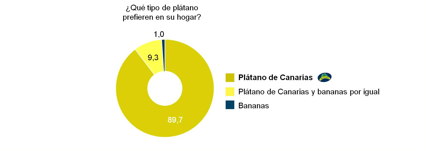As an advertiser, it is important to know whether one is fulfilling the role of advertising in the marketing mix, collaborating in increasing sales and prices, or in other words, how to know whether our advertising agency is doing it right or wrong. There is no better example here than the Plátano de Canarias advertising campaigns.
One of the great objectives of the Plátano de Canarias Producer Organisations Association (ASPROCAN) is that the whole of the production should be sold each year and at the best possible price.
Achieving this depends on many factors and not all can be controlled from ASPROCAN, there are obviously “uncontrollable” external factors that can influence whether or not all of the Plátano de Canarias are sold and at a good price, such as the production and offer of bananas at a given time or the appearance of seasonal fruit.
However, there are other internal factors where the sector and Asprocan can intervene more, such as the volume produced, the volume sent to the peninsula, the prices at origin, the quality of the product or the advertising. This last factor is one more of many, and we will try to ensure that this has a positive influence on whether all produced Plátano de Canarias are sold and at a good price.
To understand the extent to which advertising can help to achieve this, it is necessary to know all the variables that can affect the price to the farmer, the most determining of which is the relationship between the offer and the demand. This market law is only escaped from, and only to a certain extent, by products that have managed to be distinguished from the competition with a renowned, appreciated “premium” brand.
Consumers are willing to pay more for these products thanks to these brands. These brands, their notoriety and the good image can only be achieved if our initial product really excels over the competition in something appreciated by consumers, based on the right, constant advertising.
This is clearly seen in examples from our horticultural and fruit sector, such as the Chiquita bananas on the German market, Marlene apples in Italy or the Zespri kiwis in Europe. All of these brands invest constantly in advertising, are sold at a higher price, are leaders in their markets and are not so affected in their prices by the ups and downs of offer and demand.
This does not mean that advertising is made and their sales and value increase automatically, for at least two or three years are needed to obtain the first positive results, as long as everything is done well. In other words the minimum necessary and sufficient investment must be made in these years with good planning and purchasing of media, the target must be hit with creativity and the communication strategy must be well-chosen.
In order to determine whether a producer or sector has done it right with their advertising, in marketing the concept has been established of the “value of the brand”, which informs us of the advertising efficacy achieved in the medium and long term. This value is determined by the percentage of consumers of a product who have been persuaded to buy this brand and how much more they are willing to pay for it than the competition.
In order to know whether the advertising that agr! has made for ASPROCAN is working and how well, and whether the Advertising Commission has done its job properly of setting targets and choosing proposals, it is only necessary to see how many Spaniards prefer the Plátano de Canarias and how much more they are willing to pay over the others, and to multiply this amount by the kilograms sold each year.
The ASPROCAN Advertising Committee periodically commissions independent market research to see how these results are going, just as all large advertisers do. At the present time, ASPROCAN commissions out this study to the German multinational GFK and the 2012 results are the following:
A. Nivel de preferencia hacia Plátano de Canarias: los resultados de preferencia alcanzados por la marca Plátano de Canarias son difícilmente superables, alcanzando ya el 89,7%.

B. How much more are you willing to pay for one kilogram of Plátano de Canarias?:

87.7% of those interviewed are willing to pay more than 30 cents/kg for a banana with a better flavour!
As the advertising continues to do its job better, the Plátano de Canarias “value of the brand” will increase. This will make more people willing to pay more for our bananas and therefore move us away from the low prices bananas achieve when they flood the markets, which is something that drags down the prices of Plátano de Canarias. Furthermore, this information must cause reflection in the sector, which should not compete at times of surplus by lowering the price beyond this cushion of 30 cents with respect to other bananas.
Furthermore, these good results are not the result of one campaign, but of several that have worked well over time. Therefore, the Asprocan Advertising Committee in each campaign controls to what extent the advertising targets for the year have been met. In this second area of annual control carried out by the Advertising Committee, three parameters of efficacy are measured:
First it is checked whether the campaign has been seen sufficiently by our target audience (in the 2012 campaign the target are housewives). To do this, what was planned and what has been achieved with the planning and purchase of media are assessed. A good campaign serves for nothing if it is not seen. The 2012 results were optimal:

Secondly, it is checked whether the campaign has gone down well, for if acceptable levels are not achieved, no attention is paid even though the commercial might be put on many times. The message fails to get through, and therefore it does not work.
The 2012 results in this area are excellent, for 85% of those surveyed like our campaign a lot or quite a lot, when a positive result would be an average 75.8% according to the statistical checks of the studies made by GFK:

And the third parameter of efficacy is the communication strategy. In other words, the message implicit in the creativity must increase the “value of the brand”, the positive willingness to choose it and pay more for it. In this year’s strategy in agr!, the emotional path was chosen, which consisted of transmitting a value: that everything that is worthwhile is hard to get, thus stressing how hard it is to get the flavour of Plátano de Canarias. This also gave very good results:

As can be seen, if things are done better in advertising each year, it gives results in the medium-long term by increasing the “value of the brand” and making more people willing to pay more for our Plátano de Canarias brand, which has recently achieved strong backing with the transitory approval of the Protected Geographical Indication (Indicación Geográfica Protegida – IGP) Plátano de Canarias, which will open up new opportunities.
Furthermore, in order to ensure that prices do not fall much at a certain time (increase in production or expected fall in consumption) sporadic promotions are made at the points of sale, with incentives to push on commercialisation. When the incentive is over, the motivation ends, but the “value of the brand” always works. We have seen that these kinds of promotions are important, for example, at the long weekend in the first week of December to ensure that prices do not fall after these dates.
Without knowing how the efficacy of advertising is measured and what its role is in all of the marketing variables, it is impossible to give a serious judgement on its importance and efficacy. With this reflection, I hope to have contributed to making a correct and necessary assessment of the work of advertising both in the long term with the “value of the brand”, and in the short term with what is achieved on the advertising level in each campaign.

